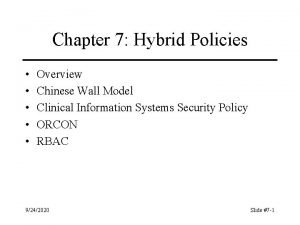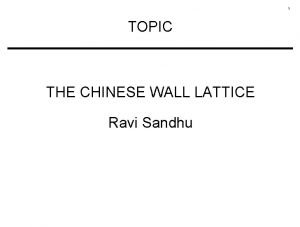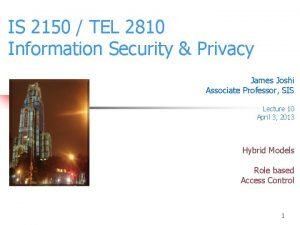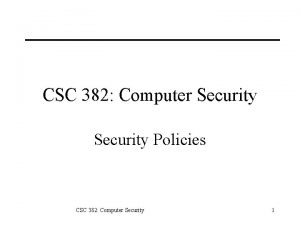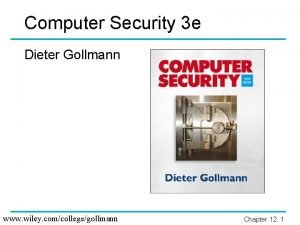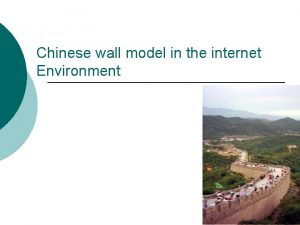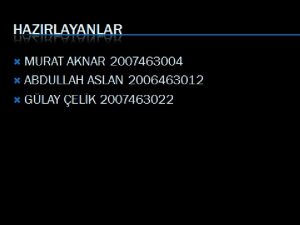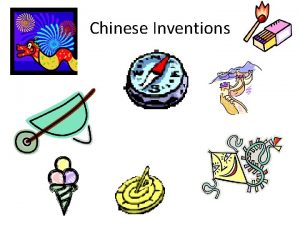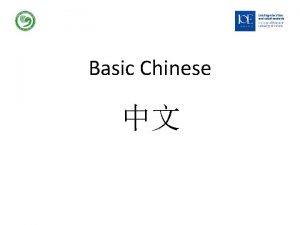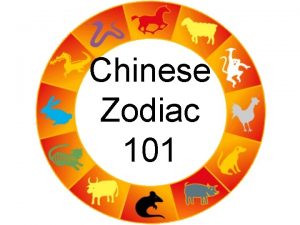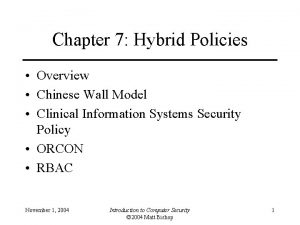Chinese wall model in the internet Environment 1


















- Slides: 18

Chinese wall model in the internet Environment 1

Agenda Introduction ¡ Chinese wall Model Policy ¡ Simple security rule ¡ Chinese wall in www. ¡ l l Authentication. Authorization. 2

introduction ¡ The goals most often specified in a security policy are : l l l confidentiality - prevention of unauthorized access and theft of information. integrity - prevention of unauthorized modification of information. availability - prevention of denial of service. 3

introduction ¡ ¡ Chinese Wall security describe how to reach these goals. It’s a commercial security policy. The Chinese Wall security policy focuses more on confidentiality. The Chinese Wall security policy is perhaps as significant to some parts of the commercial world as Bell and La. Padula’s policies are to the military. 4

introduction It can be distinguished from Bell-La. Padula policies by the way that a user’s permitted accesses are constrained by the history of his previous accesses. • The Chinese Wall security policy was identified by Brewer and Nash. It is a real commercial policy which can be formally modelled. Its basic idea is to keep company information confidential and prevent it from unauthorized access of consulting services. l 5

Chinese wall Model Policy ¡ All corporate information is stored in hierarchically arranged filling system. It consist of three levels : l At the lowest level , individual items of information (objects) is considered, each concerning a single corporation. l At the intermediate level , all objects which concern the same corporation are grouped into a company dataset. l At the highest level , all company datasets whose corporations are in competition are grouped together. Each group is referred as a conflict of interest class. 6

7

Chinese wall Model Policy ¡ Associated with each object is the name of the company dataset to which it belongs and the name of the conflict of interest class to which that company dataset belongs. 8

Chinese wall Model Policy ¡ If the system maintained information on Bank-A , Oil Company-A and Oil Company-B : l All objects would belong to one of three company dataset ( “bank-A” “oil company-A” or “oil company-B” ) , l There would be two conflict of interest classes , one for banks ( containing Bank-A’s dataset ) and one for petroleum companies ( containing Oil company-A’s and Oil company-B’s dataset. 9

10

Chinese wall Model Policy ¡ The basis of the Chinese Wall policy is that people are only allowed access to information which is not held to conflict with any other information that they already possess. 11

Chinese wall Model Policy ¡ Thus , in consideration of the Bank-A , Oil Company-A and Oil Company-B datasets , a new user may freely choose to access whatever datasets he likes ; as far as the computer is concerned a new user does not possess any information and therefore no conflict can exist. 12

Chinese wall Model Policy ¡ ¡ ¡ Suppose the user accesses the Oil Company-A dataset first. The user now possess information concerning the oil company-A dataset. Later , he requests access to the Bank-A dataset This is quite permissible since the Bank-A and Oil company-A datasets belong to different conflict of interest classes and therefore no conflict exists. 13

14

Chinese wall Model Policy l However, if he requests access to the oil company-B dataset the request must be denied since a conflict does exist between the requested dataset ( Oil Company-B) and one already possessed (Oil Company-A). 15

16

Chinese wall Model Policy ¡ ¡ ¡ It does not matter whether the oil company-A dataset was accessed before or after the Bank-A dataset. However, were Oil Company-B to be accessed before the request to access the Oil Company-A dataset , the restrictions would be quite different. In this case access to the Oil Company-A dataset would be denied and the user would possess { “Oil Company-B“ , “Bank-A” } ( as opposed to the request to access the oil Company-B dataset being denied and the user possessing { “Oil Company-A” , “Bank-A” } ). 17

Chinese Wall Model In www ¡ To realize the Chinese Wall security policy we need user labels that contain information about the user’s identity and objects already accessed by him. We require mechanisms that reliably provide authentication and authorization by user profiles that support an interface to software run in the world wide web. 18
 Chinese wall model example
Chinese wall model example Brewer-nash model (chinese wall)
Brewer-nash model (chinese wall) Chinese wall model
Chinese wall model Chinese wall model
Chinese wall model Chinese wall model
Chinese wall model Computer security gollmann
Computer security gollmann Chinese wall model
Chinese wall model Anglo chinese school primary
Anglo chinese school primary Sound wall phonemic awareness
Sound wall phonemic awareness Chris brown wall to wall
Chris brown wall to wall Cut brick lengthwise
Cut brick lengthwise Members used to carry wall loads over wall openings
Members used to carry wall loads over wall openings Lemon diagram
Lemon diagram Financial environment of business
Financial environment of business Internet micro environment
Internet micro environment Ffeic authentication guidance
Ffeic authentication guidance Osi model vs internet model
Osi model vs internet model What is internet
What is internet Hình ảnh bộ gõ cơ thể búng tay
Hình ảnh bộ gõ cơ thể búng tay
